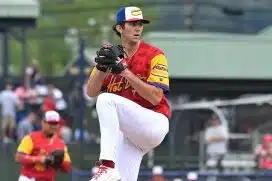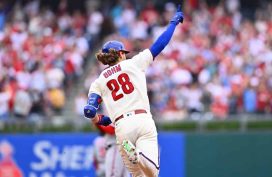By: Jason Ferrie, Sports Talk Philly Columnist
The Philadelphia Phillies currently find themselves in second-place in the National League East (12-15) while watching a few key players come out of the gates a little slow. One of those players is first baseman Tommy Joseph. Coming into this season, the Phillies and fans had big expectations of the 25-year-old, who emerged as a power bat last season—finishing with a .505 slugging percentage and 21 home runs. Early this season, he is struggling at the plate, posting an early .192/.250/.315 triple-slash. It is early in the season, but should the Phillies be concerned with their first baseman?
At the end of last season, there was some optimism that the Phillies had found their first-baseman of the future in Joseph, but in the early going of this season there is some concern. Slumps and slow starts happen, it is the nature of the game, but there is some validity to the question given the smaller sample we still have on Joseph. Last season, Joseph mashed everything thrown his way, posting a slugging percentage of .500 or greater against four-seamers and sliders—which were the two most commonly thrown pitches to him. So far this season, Joseph is struggling from an average and slugging percentage perspective against both of those pitches.
While those numbers are not living up to where Joseph was in 2016, the batted ball numbers are generally in line with where he was last season. So far this season, Joseph is averaging an 89.1 MPH exit velocity in 51 batted ball events, according to Baseball Savant. Last season, Joseph had an average exit velocity of 89.9 MPH in 283 batted ball events. Even on ground balls, Joseph averaged 87 MPH on ground balls last season and this season is averaging 86.2 MPH. If we move onto fly balls and line drives, which Baseball Savant lumps together, Joseph averaged 94.5 MPH in 2016—which is the exact same exit velocity he has on those batted ball events this season. Sticking with the batted ball theme, Joseph averaged an exit velocity of 95 MPH or greater on 41.9-percent of batted ball events last season. Moving on to this season, Joseph is still striking the ball similarly with a 41.2-percent rate.
Phillies Rumors: Jeremy Hellickson 'loves Philly,' may be interested in staying
The biggest difference that we will see in the batted ball data provided by Baseball Savant is the number of barrels for Joseph. Baseball Savant counts barrels as well-struck batted balls with an estimated batting average/slugging percentage above .500/1.500. Last season, Joseph managed to barrel the ball on 11.8-percent of batted ball events. To this point in 2017, Joseph has barreled the ball on just 3.9-percent of batted ball events. Even though Joseph is striking the ball similarly on his batted ball events in terms of exit velocity, he is not catching the barrel nearly as often this season.
One thing that reduces the potential outcomes of at-bats in putting the ball on the ground. Simply put, you can’t hit a home run by putting the ball on the ground. In 2016, Joseph put the ball in the air on 45.1-percent of his batted balls. In 21 games this season, his fly ball percentage has dropped to 37.3-percent. With the decrease in fly balls came an increase in the number of balls put on the ground, jumping from 37-percent in 2016 to 51-percent this season. One cannot expect Joseph to be hitting home runs — which carried much of his offensive value last season — if he isn’t giving himself the opportunity.
The other drop that Joseph has seen this season is his home run to fly ball rate. Last season, Joseph posted a home run to fly ball rate of 18.9%, which ranked 20th among first baseman with at least 200 plate appearances. Through his first 73 plate appearances, Joseph has posted a home run to fly ball rate of 10.5-percent, which ranks 19th amongst qualified first baseman. Speaking of fly balls, there is one area where Joseph leads and that is on infield fly ball rate, which is 26.3-percent. The next closest first baseman is Adrian Gonzalez at 16.7-percent. For reference, no first baseman with 200 or more plate appearances posted an infield flyball percentages greater than 16.3-percent in 2016. It is hard to imagine he will sustain the rate of infield fly balls he is hitting this season.
Trending: Ryan Howard becomes partner in SeventySix Capital
The biggest early concern for Joseph should be his strikeout rate, which has jumped from 21.6-percent to 28.8-percent. For starters, Joseph has not been a high on-base guy to this point in his career, so increasing the number of strikeouts is less than ideal. While his early season walk rate is up slightly from 6.3-percent to 7.5-percent, a seven percent increase in strikeouts would spell trouble for Joseph. Some of the increase in strikeouts may be explained by increases in his plate discipline. In 2016, Joseph chased pitches outside of the zone 34.8-percent of the time, according to Fangraphs Pitchf/x data. This season that number has increased to 37.7-percent. To add onto that, Joseph made contact 64.9-percent of the time when swinging at pitches outside of the zone. This season he was made contact just 52.5-percent of the time. Even on pitches in the zone, Joseph is making less contact. In 2016, the Phillies first-baseman made contact on 86.3-percent of pitches in the zone. This season he is making contact on 82.1-percent of pitches. The decrease in contact on pitches inside and outside of the zone should be concerning for the Phillies. To add onto that, Joseph is posting a swinging strike rate that is significantly higher than last season. This season he is swinging and missing at 15.5-percent of pitches compared to 11.1-percent in 2016.
The exit velocity that Joseph has displayed this season brings optimism that he could turn his season around and be closer to the player we saw in 2016. The biggest difference that he will need to change is his hit distribution, since most his batted balls are on the ground. Joseph has not been a high on-base player during his time in the majors and as previously stated, the majority of his value is tied into his power. That can only come from the ball being off the ground. If Joseph cannot make the necessary adjustments at the plate and start lifting the ball again, the Phillies may be forced to look at other options such as Rhys Hoskins who has posted a .337/.431/.651 triple-slash in his first 86 at-bats with Triple-A Lehigh Valley.







